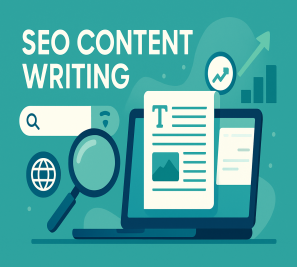Are you struggling to get your content noticed online despite your best efforts? You’re not alone. With the ever-evolving landscape of search engine algorithms, it’s becoming increasingly challenging to create effective SEO content that drives results.
(Click the picture to try Oreate AI SEO Content Generator⬆️)
In this comprehensive guide, we’ll walk you through the step-by-step process of SEO content writing to help you rank high in 2025. You’ll learn about the key elements of high-quality content and how to avoid common mistakes. By the end of this guide, you’ll be equipped with the knowledge and tools necessary to create effective content that resonates with your audience and search engines alike.
The Evolution of SEO Content in 2025
As we step into 2025, the world of SEO content is undergoing significant transformations. The way search engines operate has changed dramatically since 2023, impacting how content is optimized and ranked.
How Search Engines Have Changed Since 2023
Search engines have become more sophisticated, incorporating advanced AI and machine learning algorithms to deliver more accurate and personalized results. This shift has led to a greater emphasis on content optimization and on-page SEO techniques that cater to both user intent and search engine requirements.
| Change | Impact on SEO |
|---|---|
| Advanced AI algorithms | More accurate search results |
| Increased emphasis on user experience | Higher rankings for user-friendly content |
What Is SEO Content Writing?
SEO content writing is a specialized form of writing that aims to strike a balance between search engine algorithms and human readers. As a content creator, you’re tasked with crafting content that not only appeals to your target audience but also ranks high in search engine results.
To create successful SEO content, you need to be aware of the latest trends and best practices in search engine optimization. This includes understanding how to use keywords effectively, how to structure your content for maximum readability, and how to incorporate other SEO elements like meta descriptions and header tags.
The Critical Connection Between SEO and GEO
In the evolving world of digital marketing, SEO (Search Engine Optimization) has long been the backbone of driving organic traffic from traditional search engines like Google and Bing. It focuses on optimizing website content, structure, and technical elements to rank higher on search results pages.
Now, a new player has entered the field—GEO (Generative Engine Optimization). GEO is the practice of optimizing content so it appears in AI-generated answers from tools like ChatGPT, Google’s Search Generative Experience (SGE), Bing Copilot, and other generative search platforms. Instead of just targeting keyword rankings, GEO ensures your content is structured, clear, and authoritative enough for AI systems to recognize and include in their generated summaries or recommendations.
How GEO Complements Traditional SEO
While SEO helps your pages rank in standard search results, GEO extends that visibility into the AI-powered discovery space. By aligning your content with GEO principles—concise explanations, factual accuracy, semantic richness, and context—you increase the chances of your brand being cited or linked in generative answers.
Together, SEO and GEO form a complete visibility strategy: SEO drives clicks from classic search listings, while GEO positions your brand in the emerging AI-driven search ecosystem, ensuring your content reaches audiences wherever they search—whether they scroll or simply ask.
(Click the picture to try Oreate AI SEO Content Generator⬆️)
Key Elements of High-Ranking SEO Content in 2025
High-ranking SEO content in 2025 requires a strategic combination of essential components. To create content that not only ranks well but also provides value to your readers, you need to focus on several key areas.
(1) Keyword Optimization Without Stuffing
Effective keyword optimization is crucial for SEO success. This involves using relevant keywords naturally throughout your content, including in headings, subheadings, and meta descriptions. Avoid keyword stuffing, as it can lead to penalties from search engines. Instead, focus on creating content that flows naturally and includes keywords where they make sense.
(2) E-E-A-T Principles and Their Implementation
Google’s E-E-A-T principles (Experience, Expertise, Authoritativeness, Trustworthiness) are vital for creating high-quality content. To implement these principles, ensure that your content is written by experts in the field, is well-researched, and provides authoritative information. Building trust with your readers is also crucial, so make sure your content is accurate, up-to-date, and transparent.
(3) Content Structure and Readability Factors
A well-structured content format is essential for readability and SEO. Use headings (H2, H3, H4) to break up your content into logical sections, making it easier for readers to scan and understand. Readability factors such as sentence length, paragraph length, and the use of bullet points or numbered lists also play a significant role in keeping your readers engaged.
(4) Using H2, H3, and H4 Tags Effectively
To structure your content effectively, use H2 tags for main headings, H3 tags for subheadings, and H4 tags for sub-subheadings. This hierarchical structure helps search engines understand the organization of your content and its relevance to specific topics. It also improves the user experience by making your content more scannable.
By incorporating these key elements, you’ll be well on your way to creating high-ranking SEO content in 2025 that resonates with both search engines and your target audience.
Step-by-Step Process for SEO Content Writing
(1) Keyword Research: The Foundation of Effective SEO Content
To create content that ranks, you need to understand the keywords your audience uses. Keyword research is a critical step in SEO copywriting, helping you identify the terms and phrases your target audience searches for. By understanding these keywords, you can tailor your content to meet the needs of your audience, improving your chances of ranking higher in search engine results.
How to Identify High-Value Keywords Using Semrush
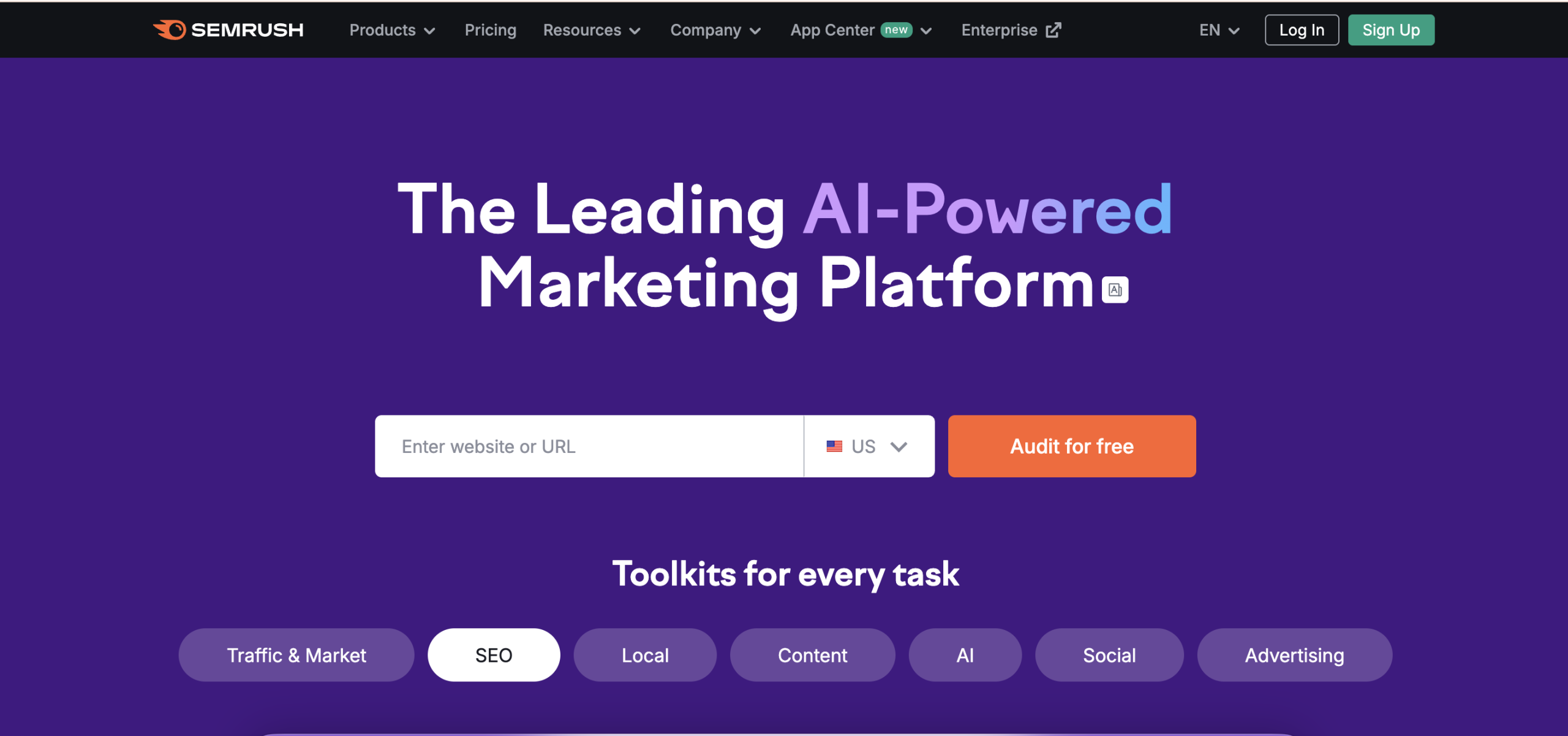
Semrush is a powerful tool for keyword research, offering insights into keyword trends, competitor analysis, and more. To identify high-value keywords using Semrush, start by entering a seed keyword related to your content topic. Semrush will then provide a list of related keywords, along with their search volume, competition level, and other relevant metrics.
Step-by-Step Process with Semrush:
- Enter a seed keyword in the Semrush search bar.
- Analyze the keyword overview, including search volume and keyword difficulty.
- Explore related keywords and phrases.
- Use the Keyword ‘Magic Tool’ to find more specific keyword clusters.
| Keyword | Search Volume | Keyword Difficulty |
|---|---|---|
| SEO Copywriting | 12,000 | 68 |
| On-page SEO | 20,500 | 89 |
| Content Optimization | 4,300 | 55 |
Note: SEMrush’s keyword difficulty score ranges from 0 to 100, with higher scores indicating greater ranking difficulty.
Analyzing Competitor Keywords with Ahrefs
Ahrefs is another robust tool for keyword research, particularly useful for analyzing competitor keywords. By understanding what keywords your competitors are ranking for, you can identify gaps in your own SEO strategy and opportunities to outrank them.
Step-by-Step Process with Ahrefs:
- Enter your competitor’s domain into Ahrefs.
- Use the ‘Keywords’ report to see what they’re ranking for.
- Analyze the keyword list for opportunities, focusing on relevance and search volume.
- Use Ahrefs’ ‘Content Gap’ tool to identify keywords your competitors rank for, but you don’t.
(Click the picture to try Oreate AI SEO Content Generator⬆️)
(2) Creating a Strategic Content Brief
To produce high-ranking SEO content, you need to start with a solid content brief. A content brief acts as a guide for your content creators, ensuring that everyone involved in the content creation process is on the same page. It outlines the objectives, target audience, and key messaging, helping to create content that meets the needs of both users and search engines.
Essential Elements to Include in Your Brief
A comprehensive content brief should include several essential elements. First, it should define the content’s purpose and the target audience. Understanding who your audience is and what they are looking for will help you create content that resonates with them. Additionally, your brief should outline the key messaging and the unique selling points (USPs) of your content.
Other crucial elements to include are the keywords you want to target, along with their search intent. You should also specify the content format, such as blog post, article, or video script, and the tone of voice to be used. Including these details will help ensure that your content is optimized for both users and search engines.
Tools for Streamlining the Brief Creation Process
Creating a content brief can be a straightforward process if you have the right tools. Several platforms can help you streamline this process. For instance, tools like Semrush and Ahrefs can assist in keyword research and competitor analysis, providing valuable insights to include in your brief.
Other tools, such as Clearscope and Surfer SEO, can help optimize your content by analyzing top-ranking pages and suggesting relevant keywords and phrases. By leveraging these tools, you can create a comprehensive content brief that sets your content up for success.
(3) Crafting Compelling Headlines and Meta Descriptions
In the realm of SEO content writing, headlines, and meta descriptions play a pivotal role in determining your content’s success. Crafting these elements effectively can significantly boost your click-through rates (CTR) and drive more traffic to your site. As we delve into the strategies for creating compelling headlines and meta descriptions, you’ll learn how to optimize your content for both search engines and users.
(Click the picture to try Oreate AI SEO Content Generator⬆️)
Formula for CTR-Boosting Headlines
Creating headlines that capture users’ attention involves a combination of creativity and strategic keyword placement. Here are some key elements to include:
- Use action verbs to create a sense of urgency
- Incorporate numbers or statistics to add credibility
- Pose a question to pique the reader’s curiosity
- Include your primary keyword to enhance SEO relevance
By incorporating these elements, you can create headlines that not only attract clicks but also align with your SEO content writing strategy.
Meta Description Best Practices for 2025
Meta descriptions serve as a crucial element in your SEO copywriting arsenal, providing a summary of your content that appears in search engine results. To maximize their effectiveness:
- Keep your meta descriptions concise, ideally under 160 characters
- Ensure they accurately reflect the content of your page
- Include your target keyword to improve relevance
- Use compelling language to encourage clicks
By following these best practices, you can enhance your content’s visibility and appeal to both search engines and potential readers.
(4) Structuring Your SEO Content for Maximum Impact
The way you organize your content can significantly impact its SEO performance. A well-structured article not only improves readability but also helps search engines understand your content better, leading to better rankings.
The Ideal Content Structure for SEO Performance
To maximize SEO impact, your content should follow a logical structure. Start with a clear introduction that outlines the main topic and its relevance. Use descriptive headings to break up the content into manageable sections. This not only enhances user experience but also allows search engines to identify key topics within your content.
An ideal structure includes an introduction, followed by main points supported by evidence or examples, and conclude with a summary or call-to-action. This structure helps in maintaining a flow that keeps the reader engaged.
Using H2, H3, and H4 Tags Effectively
Header tags (H2, H3, H4) play a crucial role in content structuring. The H2 tag is used for main headings, dividing the content into primary sections. H3 tags are used for subheadings within those sections, providing further detail. If needed, H4 tags can be used for sub-subheadings, offering additional granularity.
To use these tags effectively, ensure that each heading is descriptive and relevant to the content it precedes. Avoid skipping heading levels (e.g., jumping from H2 to H4) as this can confuse both readers and search engines. Proper use of header tags enhances the readability and SEO of your content.
(5) Writing and Optimizing the Content Body
Effective SEO content writing hinges on the ability to craft a well-optimized content body that engages readers. The content body is where you provide value to your audience, and it’s crucial for both user experience and search engine rankings.
(Click the picture to try Oreate AI SEO Content Generator⬆️)
Maintaining Keyword Density Without Sacrificing Quality
Maintaining the right keyword density is crucial for SEO without compromising the quality of your content. You should aim to use your primary keywords naturally throughout the content. For a 500-word piece, using your primary keyword, such as “SEO content writing,” around 5-10 times is sufficient. The key is to ensure that your content reads naturally and provides value to the reader.
To achieve this, you can use variations of your keyword and related terms. For instance, instead of repeating “SEO content writing” multiple times, you could use synonyms or related phrases like “content optimization” or “writing for SEO.” This approach helps in maintaining the keyword density while keeping the content engaging and diverse.
Incorporating LSI Keywords and Semantic Relevance
LSI (Latent Semantic Indexing) keywords are terms related to your primary keyword. They help search engines understand the context and relevance of your content. Incorporating LSI keywords enhances the semantic relevance of your content, making it more understandable and valuable to both users and search engines.
For example, if your primary keyword is “SEO content writing,” some LSI keywords could be “content marketing,” “keyword research,” or “on-page SEO.” By naturally incorporating these terms, you can improve the overall relevance and depth of your content.
| Primary Keyword | LSI Keywords |
|---|---|
| SEO content writing | Content marketing, keyword research, on-page SEO |
| Content optimization | SEO strategies, content quality, user experience |
Strategies for Creating Scannable, User-Friendly Content
Creating scannable, user-friendly content is essential for keeping your audience engaged. One effective strategy is to use subheadings, bullet points, and short paragraphs. This format makes it easier for readers to scan through your content and find the information they’re looking for.
Another strategy is to use bold text and italics to highlight important points. This not only enhances readability but also draws attention to key information. Additionally, incorporating relevant images and videos can break up the text and make your content more engaging.
- Use subheadings to structure your content
- Break up content into short paragraphs
- Incorporate bullet points for lists
- Highlight important information with bold text
By implementing these strategies, you can create a content body that is both optimized for search engines and enjoyable for your readers.
(6) On-Page SEO Elements You Can’t Ignore
Effective on-page SEO requires attention to detail and a thorough understanding of the elements that influence search engine rankings. As you optimize your content for search engines, there are several key on-page SEO elements to focus on.
Image Optimization Techniques
Images play a crucial role in enhancing user experience, but they can also impact your site’s load time if not optimized properly. To optimize your images, use descriptive file names and alt tags that include your target keywords. For example, instead of using a generic file name like “image1.jpg,” use “on-page-seo-techniques.jpg.” Compressing images using tools like TinyPNG or ImageOptim can also help reduce file size without sacrificing quality.
Internal and External Linking Strategies
Linking is a vital aspect of on-page SEO. Internal linking helps search engines understand your site’s structure and content hierarchy, while external linking to authoritative sources can enhance your content’s credibility. When creating internal links, use descriptive anchor text that indicates the content of the linked page. For external links, ensure they are relevant and add value to your content.
| Linking Strategy | Description | Best Practice |
|---|---|---|
| Internal Linking | Links to other pages on your site | Use descriptive anchor text |
| External Linking | Links to authoritative external sources | Ensure relevance and credibility |
Schema Markup Implementation
Schema markup is a form of microdata that helps search engines understand the context of your content. By implementing schema markup, you can enhance your search engine listings with rich snippets, which can improve click-through rates. Common types of schema markup include reviews, events, and FAQs. Use Google’s Structured Data Markup Helper to create and test your schema markup.
Mobile Optimization Essentials
With the majority of searches now conducted on mobile devices, ensuring your site is mobile-friendly is crucial. Key aspects of mobile optimization include responsive design, fast load times, and easy navigation. Test your site’s mobile usability using Google’s Mobile-Friendly Test tool and make necessary adjustments to improve user experience.
By focusing on these on-page SEO elements, you can significantly improve your website’s visibility and drive more traffic to your site. Remember, on-page SEO is just one part of your overall SEO strategy, so be sure to continually monitor and adjust your approach as needed.
Essential SEO Content Writing Tools for 2025
In the ever-changing world of SEO, using the best content writing tools is essential for achieving high rankings. As we navigate through 2025, the landscape of SEO content writing continues to evolve, making it crucial to leverage the most effective tools available.
The right tools can streamline your content creation process, improve your content’s quality, and enhance your on-page SEO efforts. Let’s explore the essential categories of SEO content writing tools that you should consider integrating into your workflow.
Keyword Research Tools
Keyword research is the foundation of any successful SEO content strategy. Tools like Semrush and Ahrefs are indispensable for identifying high-value keywords, analyzing competitor strategies, and uncovering new opportunities. These platforms provide comprehensive data on search volume, keyword difficulty, and SERP analysis, enabling you to make informed decisions about your content.
Key features to look for in keyword research tools include:
- Comprehensive keyword databases
- Competitor analysis capabilities
- SERP feature analysis
- Content gap identification
Content Optimization Platforms
Content optimization platforms like Oreate AI and Surfer SEO help you refine your content to better match search engine requirements. These tools analyze top-ranking content and provide recommendations on keyword usage, content structure, and readability.
| Tool | Key Features | Benefits |
|---|---|---|
| Oreate AI | SEO content generation, keyword placement | Improved content relevance, better keyword targeting |
| Surfer SEO | SERP analysis, content optimization suggestions | Enhanced content structure, improved rankings |
Here is a detailed guide to use Oreate AI for SEO content writing:
Step 1. Visit Oreate AI
Go to the official website and find New Project>AI Toolbox>SEO Content Generator.
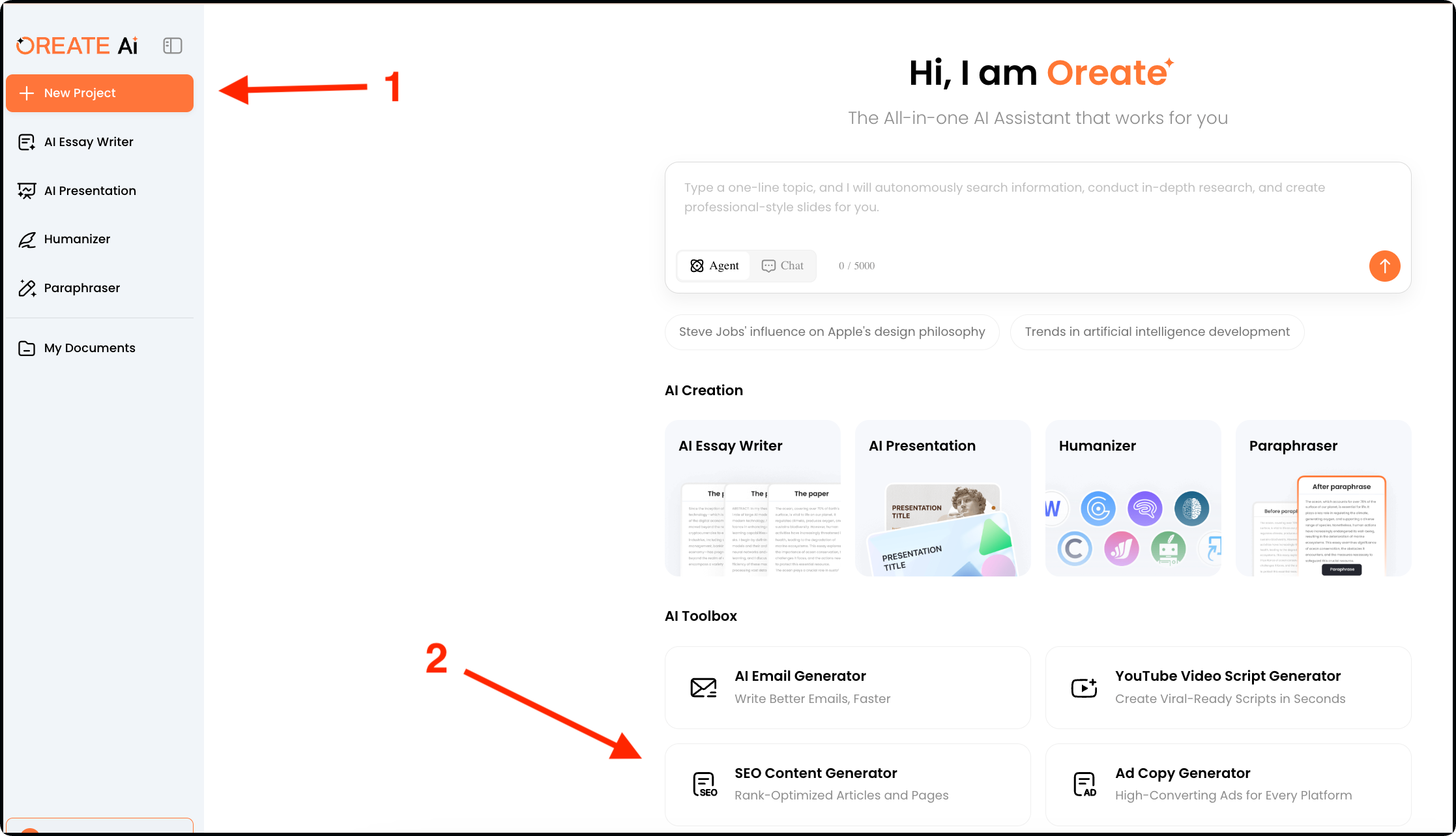
Step 2. Input Your SEO Content Topic or Keyword
Simply input what you want to generate or revise, and the agent will offer in seconds.
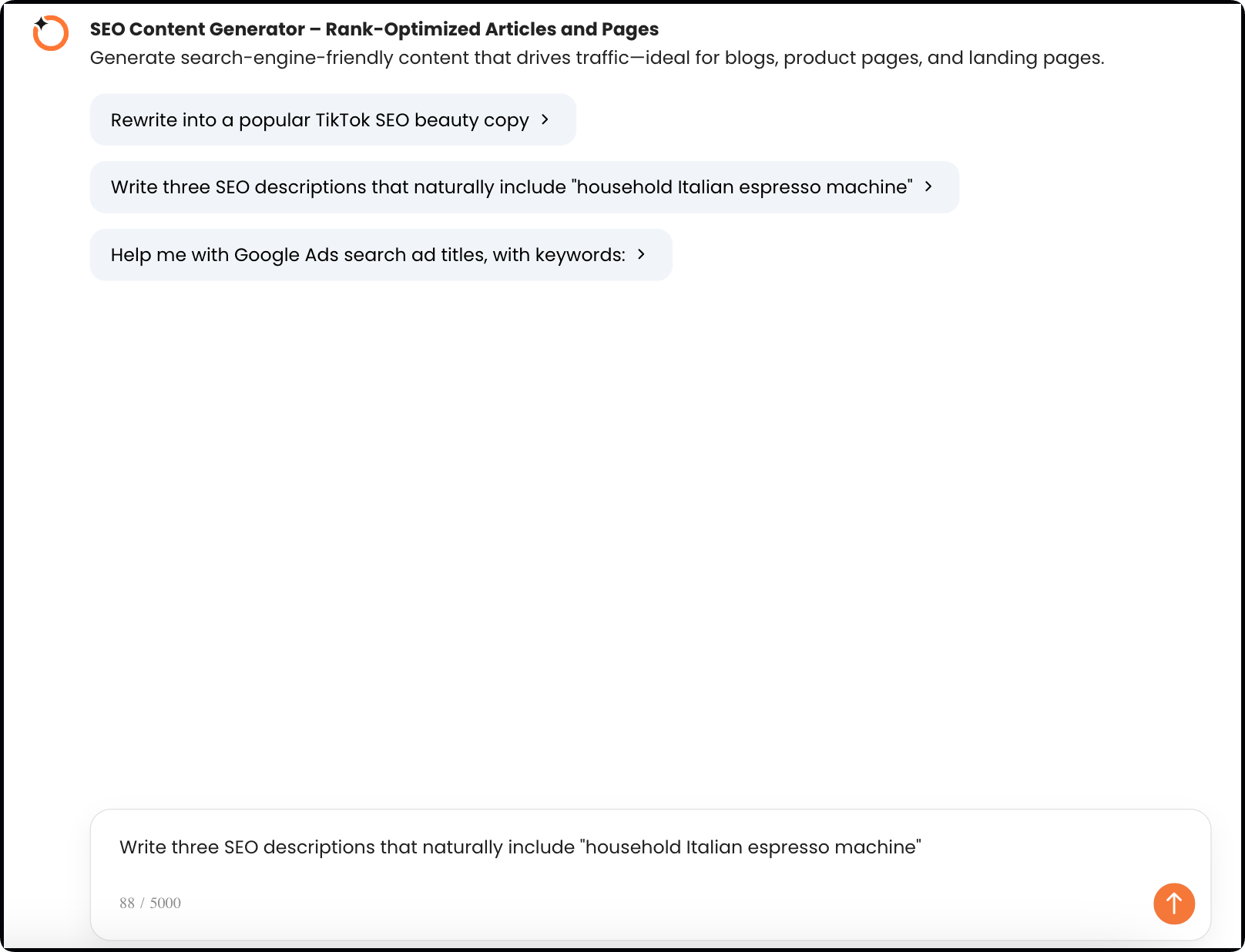
Step 3. Review and Use
Don’t forget to review and make little refinements before putting it to use.
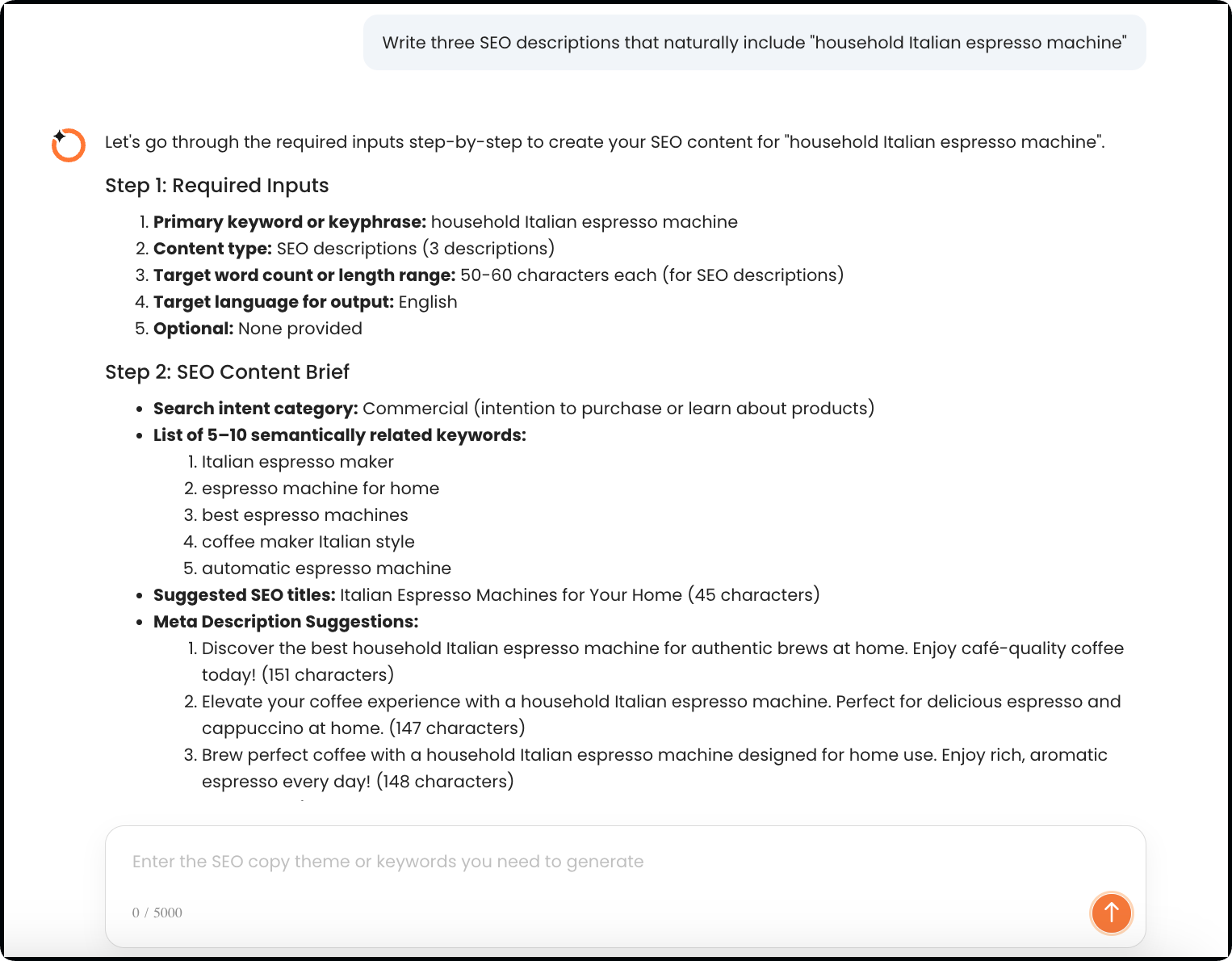
Besides SEO content writing, you can also create high-quality essays with the Oreate AI Essay Writer. Check out the guide to learn how.
Readability and Grammar Tools
Maintaining high readability and grammatical accuracy is crucial for user engagement and SEO. Tools like Grammarly and Hemingway Editor help you refine your content, making it more accessible and enjoyable for your audience.
Performance Tracking Solutions
To measure the effectiveness of your SEO content efforts, you need robust performance tracking solutions. Google Search Console and Google Analytics are powerful tools that provide insights into your content’s performance in search results, including impressions, clicks, and average position.
Key metrics to track include:
- Organic traffic
- Search engine rankings
- Click-through rates
- Conversion rates
By leveraging these essential SEO content writing tools, you can significantly improve your content’s performance and achieve higher rankings in 2025.
Common SEO Content Writing Mistakes That Kill Rankings
To rank high in search engines, you must steer clear of common SEO content writing mistakes. As you craft your content strategy, being aware of potential pitfalls can save you from losing valuable rankings.
Many SEO content writers make the mistake of relying on outdated tactics that were once effective but now harm their rankings. Understanding what not to do is just as important as knowing the right strategies.
Outdated SEO Tactics to Abandon Immediately
Some SEO practices that were once considered best practices are now obsolete. Keyword stuffing, for instance, is a tactic that involves overloading your content with keywords to manipulate rankings. This practice not only annoys readers but also triggers Google’s algorithms to penalize your site.
- Excessive use of exact match keywords
- Creating doorway pages for keyword manipulation
- Using irrelevant backlinks
Another outdated tactic is over-optimizing anchor text for backlinks. While backlinks remain a crucial ranking factor, over-optimization can be seen as spammy. Diversifying your anchor text is key to maintaining a natural link profile.
Content Quality Issues That Trigger Google Penalties
Google’s algorithms are designed to promote high-quality content that provides value to users. Content quality issues can lead to penalties that significantly impact your rankings.
| Content Quality Issue | Description | Impact on Rankings |
|---|---|---|
| Thin Content | Lack of substantial information or value | Reduced visibility in search results |
| Duplicate Content | Replicating content across multiple pages | Penalties for manipulating search rankings |
| Poor Readability | Content that’s difficult to read or understand | Higher bounce rates and lower engagement |
To avoid these issues, focus on creating high-quality, original content that addresses the needs of your audience. Ensure your content is well-structured, easy to read, and provides valuable insights or information.
By being mindful of these common SEO content writing mistakes, you can refine your strategy to improve your rankings and provide a better experience for your readers.
Conclusion
As you navigate the ever-changing landscape of search engine optimization, mastering SEO content writing is crucial for achieving high rankings in 2025. By understanding the key elements, tools, and strategies outlined in this guide, you’re equipped to create effective content that drives results and stays ahead of the competition.
Effective SEO copywriting is not just about incorporating keywords; it’s about crafting compelling narratives that resonate with your audience and meet the evolving demands of search engines. In this regard, Oreate AI can do the trick to generate content as per the users’ needs. By balancing user experience with SEO requirements, you can create content that not only ranks well but also engages and converts your target audience.
To stay ahead, continue refining your SEO content writing skills, leveraging the latest tools like Oreate AI and techniques to optimize your content for maximum impact. With persistence and practice, you’ll be well on your way to achieving SEO success in 2025 and beyond.
FAQs
What is the primary goal of SEO content writing?
The primary goal of SEO content writing is to create content that is optimized for search engines while providing value to readers, thereby increasing visibility, driving traffic, and generating results.
How has the landscape of SEO content evolved since 2023?
The landscape of SEO content has evolved significantly since 2023, with search engines prioritizing user-focused content, and algorithm updates impacting traditional SEO content strategies.
What are the key elements of high-ranking SEO content in 2025?
The key elements of high-ranking SEO content in 2025 include keyword optimization, E-E-A-T principles, content structure, readability factors, and on-page SEO elements such as image optimization, internal and external linking, schema markup, and mobile optimization.
How do I conduct keyword research for effective SEO content?
To conduct keyword research, you can use tools like Semrush and Ahrefs to identify high-value keywords, analyze competitor keywords, and understand search behaviors and trends.
What is the importance of content structure in SEO performance?
Content structure plays a significant role in SEO performance, as it improves readability, helps search engines understand the content, and increases the chances of ranking higher.
How can I avoid common SEO content writing mistakes?
To avoid common SEO content writing mistakes, you should abandon outdated SEO tactics, focus on creating high-quality content, and be aware of content quality issues that trigger Google penalties.
What are the essential SEO content writing tools for 2025?
The essential SEO content writing tools for 2025 include keyword research tools like Semrush and Ahrefs, content optimization platforms like Clearscope, Surfer SEO and Oreate AI, readability and grammar tools like Grammarly and Hemingway, and performance tracking solutions like Google Search Console.
How can I balance SEO requirements with reader engagement?
To balance SEO requirements with reader engagement, you should prioritize user-focused content, use keyword optimization techniques, and create scannable, user-friendly content that resonates with your audience.
